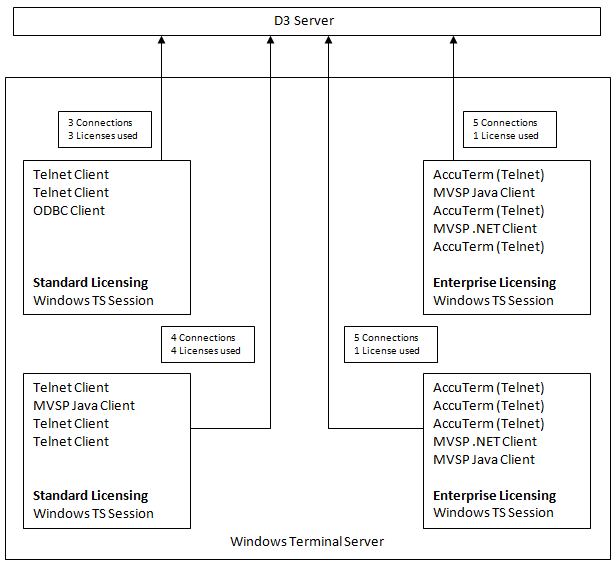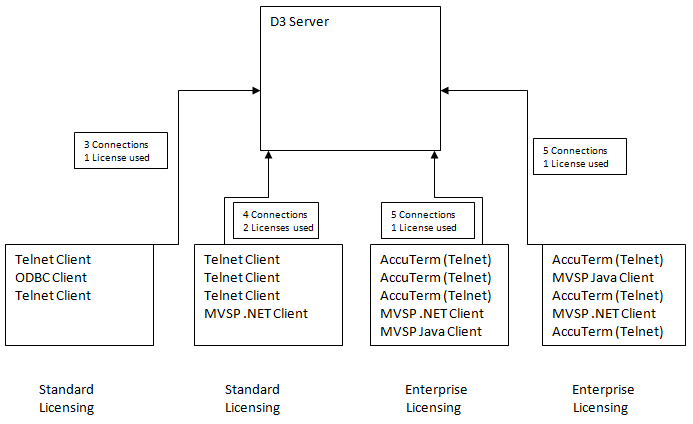
For the first connection from an IP address you will get a maximum of 3 connections for the cost of 1 user license for Turnkey Telnet, ODBC and MVSP clients. Within the 3 connections you can have a maximum of 2 of any type before additional user licenses are consumed. For example:
2 x Turnkey Telnet and 1 x ODBC = 1 user license
1 x Turnkey Telnet and 2 x ODBC = 1 user licenses
2 x Turnkey Telnet and 2 x ODBC = 2 user licenses
Every SSH connection will consume a user license.
As of D3 7.3, a user-defined 'c' function or a call to open a network socket in a D3 process running on a pib or phantom will consume a user license if one is not already consumed.
As of D3 7.4, you will receive 1 phantom license per licensed user with a minimum of 12 phantom licenses up to a maximum of 256. For example:
A 5 User system will have 12 phantom ports available.
A 25 User system will have 25 phantom ports available.
A 300 User system will have 256 phantom ports available.
With the release of D3 Linux 9.2, a new enterprise licensing option is available. This new licensing scheme allows a client to make additional connections to D3 while consuming only a single user license. Enterprise licensing can be purchased either for a single client or multiple clients.
There are two levels of enterprise licensing available:
5 connections per client
10 connections per client
|
NOTE |
The two enterprise licensing levels cannot be mixed on a single D3 server. That is, a single D3 server can support either a 5 connections per client enterprise license or a 10 connections per client enterprise license, but not both. |
Enterprise licensing is supported using the following client types:
Telnet (AccuTerm only)
|
NOTE |
A telnet client needs to connect to a turnkey pib to consume an Enterprise license. |
SSH (AccuTerm only)
MVSP .NET Client
MVSP Java Client
An enterprise license client can connect up to the maximum number of connections for the level of enterprise license purchased (using any combination of the above client types) and will only consume a single user license.
When purchasing a new enterprise license, an additional user license is included. This additional user license can be used either for standard license connections or enterprise license connections.
When upgrading an existing user license to an enterprise license, no additional user licenses are supplied.
For example:
If a D3 server is currently licensed for 10 users and 2 new enterprise licenses (at the 5 connections per client level) are purchased for 2 new clients, the total licensed users will now be 12 (10 original user licenses + 2 additional user licenses for the new enterprise licenses).
or
If a D3 server is currently licensed for 10 user licenses and 2 of the existing clients are upgraded to a 5 connection per client enterprise, the user licenses will remain at 10.
In both examples, the 2 enterprise license clients will be able to make 5 connections each, using the supported client types, and only consume 1 user license. The first connection for each client using an enterprise license will consume 1 user license and 1 enterprise license. The next 4 connections for these clients will consume no additional user licenses, but will consume the remainder of the available connections for the enterprise license. At this point, since all 5 connections have been consumed, each additional connection will consume an additional user license.
|
NOTE |
In the example above, if the additional user licenses were to be consumed by a standard license client and no more user licenses were available, enterprise license connections would be refused until a user license was released. If there are no enterprise licenses available, an additional enterprise license connection cannot be established (regardless of whether there are standard licenses available). |
Multiple connections from an SSH client are only supported using an enterprise license. Without enterprise licensing, each SSH client connection will consume 1 user license.

